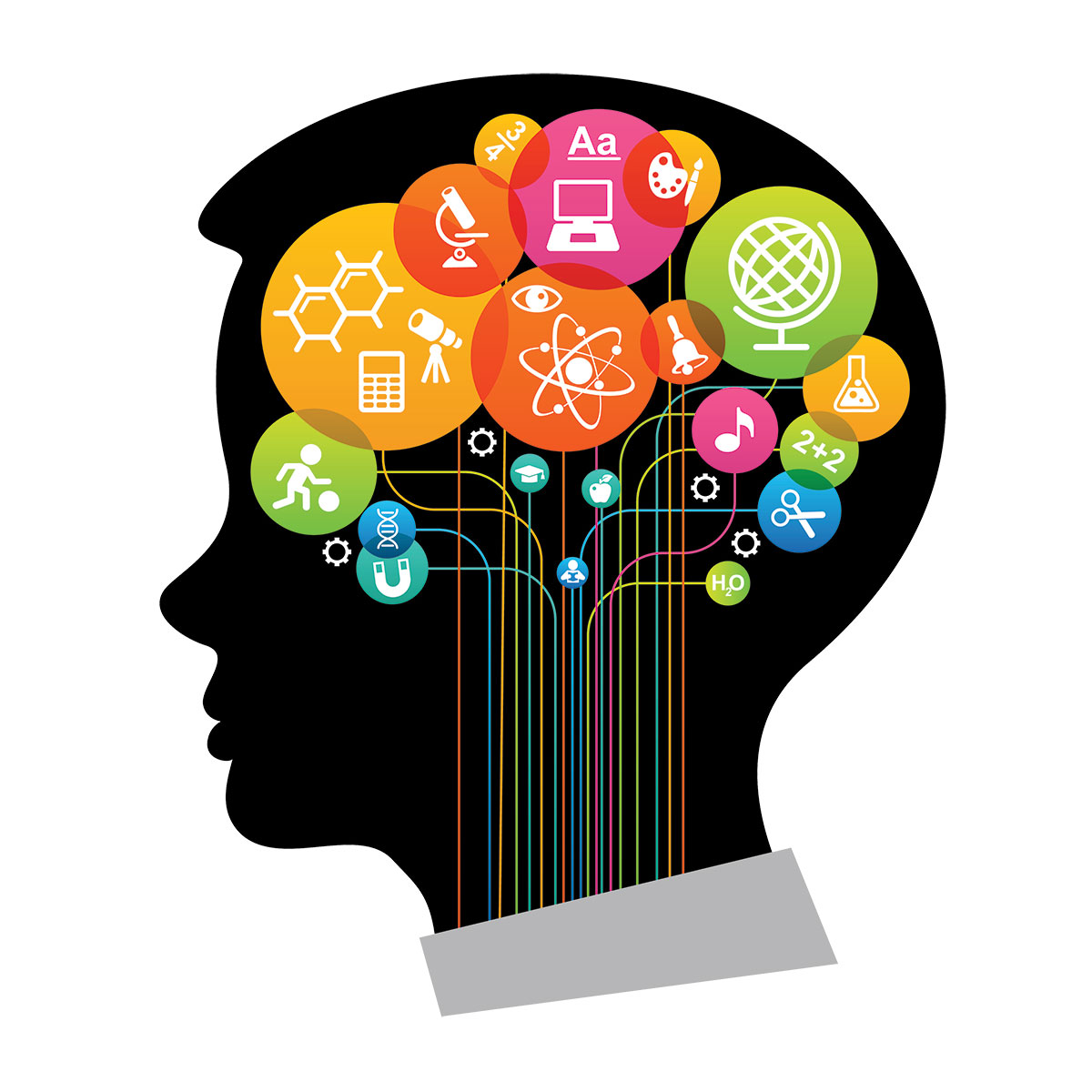
If you’ve seen the movie Lucy, you might have been left believing that we only use 10 percent of our brains. It’s a captivating idea: So much unused noggin power means we might be able to compute or accomplish . . . anything, really. If we could just engage the rest of that gray matter.
But the 10 percent thing is actually a myth. Although the brain holds 80-something billion neurons and maybe as many mysteries, scientists do know that we use virtually every part of it. And every day, we are learning more and more about how our brains develop and function, knowledge that informs how we parent, educate, influence and support our kids as they grow.
“A running joke of our researchers here is ‘Got to have another kid; with what we know now, we can finally do it right!’” says Sarah Roseberry Lytle, Ph.D., director of outreach and education at the Institute for Learning and Brain Sciences (I-LABS) at the University of Washington (UW). “We’re still in the infancy of brain research, but we know more than ever before. And the world of practice — parents and educators — wants answers.”
Researchers are sometimes hesitant to speak too early about implications of their findings — possible implementation, for instance, of lab discoveries in the nursery or classroom. But some of the investigations into how brains develop give us priceless intel, information we are starving for, says Jan-Marino Ramirez, Ph.D., professor of neurological surgery and director of the Center for Integrative Brain Research at the Seattle Children’s Research Institute.
Ramirez oversees a downtown Seattle space where specialist researchers in lab coats hover over a $1 million laser microscope, check minus-80-degree fridges filled with brain tissues (“brain banks,” as the researchers call them) and create the customized mice models used in investigations (they can, for example, breed mice to exhibit the exact problems of autistic children). Scientists hone in on questions and clues around obstructive sleep apnea, neural networks, media overstimulation and hyperactivity, temporal processing, epilepsy, the effects of fructose on the brain and more.
Bringing the newest brain findings from the lab into the hands and minds of doctors, families and educators is the ultimate goal, Ramirez says. “Every mother knows too much screen time or sugar is bad. You can Google it,” he says. “But now we can show evidence of what it does to the brain.”
Technology is facilitating research more complex than ever before, says Rob Piercy, spokesperson for the Allen Institute for Brain Science. Even so, searching for the cause of a physical or developmental issue or disease, or trying to track the cellular location of the bit players in our human dramas is, he says, “like trying to find a particular grain of sand at Golden Gardens beach.”
And yet, across disciplines, and in mind-boggling ways right in our own Puget Sound backyard, scientists are sifting, sifting.
Language
Little learners
The space used by Rechele Brooks, Ph.D., is not what you might imagine a brain science lab looks like: A hospital-blue sheet covers one wall, an assortment of big plastic peg beads and sorting rings waits on the sidelines. And cameras: There are spy cameras.
But what happens here in one of the spaces at I-LABS, where Brooks, a psychologist, conducts research, is teaching us about what it takes for humans to learn language. And the more we know about how the baby brain builds language, the more we can apply what we’ve learned to our child-rearing choices: How should we engage with our babies, for instance? What do we choose to expose them to? What’s worth our financial investment, when every app, toy and parenting class costs cold, hard cash these days?
“Sure, our brains are wired to learn, but what are their abilities and how do they help babies pull out parts of language?” asks Brooks.
Experts already know that interacting with a real person matters a lot when the phonetic building blocks of language are being formed. (So, parents: Plopping the kiddo in front of an “educational” or foreign-language cartoon is not really going to teach language the way face-to-face human interaction does.) Experts also already know that the baby brain is primed to easily learn a broad spectrum of sounds from multiple languages — Japanese babies can recognize, for instance, differences between the sounds ra and la, which Japanese adults who have not learned English cannot.

Scientists at I-LABS wanted to understand how a key facet of social interaction called gaze shifting — when babies look from an object to the face of an adult and back to the object — impacts second-language learning.
To understand this, Brooks and her colleagues assembled English-learning 9-and-a-half- to 10-and-a-half-month-old babies who had never been exposed to Spanish in the blue-sheet room with a Spanish tutor. Over the course of 12 meetings, the tutor engaged the infants in Spanish while reading books and introducing new toys. Researchers predicted that the kids who shifted their gaze more would exhibit the most second-language learning later.
After the tutoring sessions were finished, researchers analyzed video of the babies’ gaze shifts and tested the babies’ gained language skills via an EEG cap. As they thought, the babies who shifted their gaze to their tutor more often learned the most Spanish. The outcomes were just published in the online journal Developmental Neuropsychology.
“It’s not often that we can take real-life situations and match it with what is happening in the brain,” Brooks says of the study.
So, parents, if you are deciding between a bilingual day care or that set of second-language iPad apps, take note.
“The research says TV is not enough,” Brooks says. “Babies learn the best from people.”
Autism
Measuring risk
About one in 68 8-year-olds has been identified with autism spectrum disorder (ASD), according to estimates from Centers for Disease Control and Prevention. Across disciplines and in many labs and clinical offices around the Puget Sound region, doctors are working every day to learn more about every aspect of autism: its genetic emergence, characteristics, patterns and progression, and promising interventional opportunities.
Recently, Annette Estes, Ph.D., director of the UW Autism Center, has been working with a group of fellow researchers to delineate the early progression of ASD symptoms by measuring the development of both infants at high familial risk for ASD (high-risk infants have older siblings with ASD) and infants at low risk. In a recent study, babies were measured for cognitive development, adaptive skills and early behavioral features of ASD at 6 months, 12 months and 24 months of age.
As Estes puts it, the researchers had an opportunity to watch how autism unfolds as babies grow.
Their findings showed that in the most severely affected group of infants, 24-month-old children with ASD had atypical sensorimotor development at 6 months old. Sensorimotor differences came before the unfolding of cognitive and adaptive deficits and behavior features of autism.
It appears, according to a new paper reporting the study, that for most high-risk infants, the hallmark features of ASD — social-communication deficits and repetitive behavior — aren’t evident until 12 months of age or later. Other developmental differences such as reduced motor control (characterized by persistent head lag at 6 months) and less eye contact in the first year may be characteristic of infants later diagnosed with autism.
As many as 19 percent of siblings of children with ASD will also have autism, Estes says. Studying higher-risk children provides “a unique, real-time window into development” of ASD, and tracking the timing and pattern of symptoms can lead to earlier identification of autism.
“Parents have so many worries about their babies, especially if the older child has autism,” Estes says.
According to her team’s research, learning about the timing and progression of early developmental differences in infants who go on to develop autism could ultimately help doctors alter the early course of ASD, develop intervention opportunities, and ameliorate later symptoms.
Estes says researchers originally thought that if they started their study of high-risk children at 6 months of age, they would be able to see much of ASD unfold. Instead, early signs were already there. So, she says, they plan to go backward next, studying babies as young as 3 months. Many families and practitioners will be waiting for their insights.

Emotional Regulation, Stress and Trauma
Negative thinking
We already know kids get stressed, flustered, depressed, even wild sometimes. We’ve seen them lacking in control, whether it’s our 2-year-old throwing an epic grocery-store tantrum, a tween sneaking screen time when they know it’s not allowed, or a moody teenager sent to the principal’s office after losing their cool at school.
We can talk discipline all we want, but the more we understand what happens inside kids’ brains — and how brain development reacts to environmental impacts — the more we will know about how to help children regulate their emotions and succeed.
The recent research conducted by Kate McLaughlin, Ph.D., to be published in the Journal of the American Academy of Child and Adolescent Psychiatry, began with two simple questions: How do environmental experiences in childhood shape cognitive and emotional development, and how might adverse experiences put kids at risk for later mental health problems?
To find out, McLaughlin, a child clinical psychologist, psychiatric epidemiologist and director of the Stress and Development Laboratory at the UW, assembled a group of kids ages 13–19. Half the kids had been exposed to physical or sexual abuse. McLaughlin and her team then showed the teens negative and positive emotional stimuli, and measured their brain activity in response using MRI.
It turns out, the youths who had been exposed to maltreatment showed heightened response to negative emotional stimuli in the parts of the brain connected to emotional regulation and executive function. As McLaughlin explains it, in these kids, “a wider range of environmental characteristics might get classified as a threat and trigger fear symptoms. They have much stronger emotional reactions — from seeing two kids get into a fight, or even if someone has a sad expression. Also, they have a harder time modulating their emotional response to negative stimuli; it takes more cognitive resources for them to come back down to baseline.”
This can tell us something important about how to help kids who have been exposed to trauma. Before even getting into cognitive behavior therapies, McLaughlin says, helping kids learn to modulate their emotions by using breathing and relaxation techniques is key.
There are implications for the school environment, too. “Kids who have experienced trauma are going to look more emotionally reactive. Changes in the classroom, even slight, will impact them,” McLaughlin says.
Educators are hungry for this research, she says, and the potential benefits could impact entire school communities and cultures, not only kids having trouble. “When you understand that these kids are having a very hard-wired response [to stress], you can create classrooms that are more responsive to their needs.”
Next, McLaughlin plans to measure the impacts of poverty and emotional deprivation.

Regulate that
As parents, we know kids will be exposed to stress, from traumatic environments to academic stress to social pressures. But what helps kids react in a better way to that stress? Why do some kids cruise along, juggling tough stuff, while others break down?
We already know that executive function — the group of brain functions that manage cognitive processes such as planning, organization, memory, time management and flexible thinking — can buffer the effects of adversity: Kids exposed to stress are less negatively affected by that stress if they have better executive function, says Liliana Lengua, Ph.D., a UW psychologist and the director of the Center for Child and Family Well-being. The problem is, kids in certain groups, for instance kids in low-income families, are exposed to more stress that disrupts the development of executive function and are less likely to be exposed to the type of parenting that builds executive function. “More negativity and harsher parenting means there’s less scaffolding or support” for children, she explains. It’s a problematic loop.
Lengua wanted to measure what happens when parents of preschool-age children are given tools to parent in a way that helps their kids build executive function. It turns out, when a family maintains effective parenting (warm relationships, consistent and appropriate setting of limits, and coaching), the kids develop executive functions skills that then buffer them against adversity, even if the family’s stress, say of a lost job or divorce, is still there.
Lengua looks at older kids, too, to measure how executive function is built, and the demands placed on those skills as kids enter preadolescence and adolescence. She wants to learn more about how open the window for building executive function is, and how to better help kids use planning and organizational coaching, self-regulation skills and mindfulness.
With a big om, we’ll wait patiently for what intelligence comes next.
Full speed ahead
For every scientific inquiry we’ve explored here, there are dozens more happening right now in labs and computers around our region. With every passing year, we as parents have more remarkable data at our fingertips about how our children’s brains develop. We can use this intelligence to understand them, to treat them, and, ultimately, to help them succeed.
Yet even as we wait eagerly for the next insight or discovery, we should remember that the brain and the mind are not always considered to be the same things. The brain is an animal’s organ, a miraculous one to be sure. But the mind manifests our uniquely human thoughts, emotions, and hopes — it is where we manufacture the dreams we hold for our children.
In our minds, we often know already what our children are communicating to us, what they need. Our parenting consciousness, perhaps the most powerful tool of all, already sits within us. Scientists acknowledge that often their research confirms, or proves, what we believe in our minds — what feels right to our common sense and our parenting gut.
The new science of the brain and the ancient mind of the parent together will launch us into a new frontier.
Discover more about the brain
Kid brainiacs
Eric Chudler, Ph.D., is nuts about the brain. Luckily for parents and educators, he’s also wild about the minds of kids. Right near his shelves of neuroscience and research books, inside the University District office funded by a National Science Foundation grant, the UW psychologist and director of the Center for Sensorimotor Neural Engineering has stacks of kids’ drawings and poems from all around the world. Chudler hosts an annual contest challenging students to create cranium-themed art, and he gets thousands of submissions.
It’s one of the many ways Chudler engages young minds around learning about the mind through his Neuroscience for Kids program. Teaching students (as well as teachers, who then transmit knowledge back to kids) about brains, spinal cords, neurons and senses ensures that kids will obtain essential and emerging knowledge. It also preps the next generation of scientists and researchers.
Chudler’s program offers a neuroscience newsletter for kids; trains K–12 teachers; advocates for increased brain education in schools; and hosts lab and neuroscience camps for students where, for example, kids can measure and track cockroach data.
“We all know someone with a brain injury or neurological problem: Alzheimer’s, Parkinson’s, multiple sclerosis,” Chudler says. “These impact our families. It’s critical for our kids to be scientifically literate.”
Mind-mapping!
The Allen Institute for Brain Science’s BrainSpan atlas is an ambitious big-science initiative to create a map of the transcriptome ― the sum total of all the messenger RNA molecules expressed from the genes of an organism — across the entire course of human development. Researchers last year published a detailed map of where different genes are turned on and off  during mid-pregnancy. The map displays the data at unprecedented anatomical resolution, providing insight into diseases that are linked to early brain development, such as autism, and to the origins of human uniqueness. It allows researchers to take genes that they have associated with any developmental disorder and pinpoint exactly when and where that gene is being used. And, as with all of the Allen Institute’s brain atlas resources, the data is publicly available to anyone around the world. See a video about the project and learn more about other Allen Institute brain-mapping initiatives here.
during mid-pregnancy. The map displays the data at unprecedented anatomical resolution, providing insight into diseases that are linked to early brain development, such as autism, and to the origins of human uniqueness. It allows researchers to take genes that they have associated with any developmental disorder and pinpoint exactly when and where that gene is being used. And, as with all of the Allen Institute’s brain atlas resources, the data is publicly available to anyone around the world. See a video about the project and learn more about other Allen Institute brain-mapping initiatives here.
Power of touch
Parents know by instinct that touch is an essential way we communicate with our babies, and they with us. Find out what I-LABS researchers recently discovered about how a baby’s brain responds to touch here.











